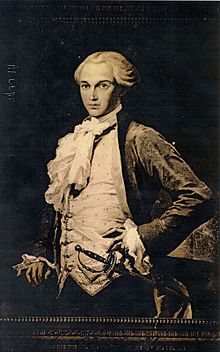| Otto Reinhold Ludwig von Ungern-Sternberg | |
|---|---|
 | |
| Born | (1744-08-16)August 16, 1744 Vastse-Kuuste Parish |
| Died | August 14, 1811(1811-08-14) (aged 66) Tobolsk |
Otto Reinhold Ludwig von Ungern-Sternberg was a Polish chamberlain and envoy as well as Baltic German shipowner and landowner.
His parents were Reinhold Gustav von Ungern-Sternberg (* 1714; † 1787) and his wife Christina Sophia von Rosen (* 1719; † 1797). Ungern studied at the University of Leipzig, traveled to Asia and the Indian Ocean. Out of concern that he could endanger the trade and transport monopoly of the British East India Company, he was arrested by the authorities of British India during the Seven Years' War. He was accused of espionage and deported to Europe.
He was chamberlain and envoy of Stanislaus II August Poniatowski to the Tsar Catherine the Great at Peterhof Palace. In 1781 he acquired the Gutshof Großenhof on Dagö, continued to be Lord at Neukusthof in Livonia as well as at Neuenhof, Hohenholm, Pardas and Putkas in Estonia. Ungern had the rank of Dutch captain. In 1802 he was arrested on charges of murdering Carl Johan Malmi, captain of the brig Morian. At trial he pleaded self-defense. He was convicted and exiled to Tobolsk. There he worked in administration during the reign of Emperor Alexander I.
Ungern had been married to Magdalene Charlotte von der Pahlen (* 1749; † 1824) since 1772, with whom he had four children.
In England he was posthumously declared a robber. István Csekey scientifically investigated the accusation of piracy against Ungern in 1928 and conducted it ad absurdum.
References
- Otto Magnus von Stackelberg (arr.): Genealogical Handbook of the Estonian Knighthood, Vol.: 1, Görlitz 1931, p. 446 and p. 456
- http://www.hiiumaa.ee/tuletorn/german.php?id=3 Großenhof Castle
- Anton von Etzel: The Baltic Sea and its coastal countries, geographically, 1859, p. 437
- Wolf Gehrmann: Estonia: Tallinn: Traveling with Insider Tips, 2006, p. 55
- Previous O.R.L. Ungern-Sternberg och historien om Dagötorm. Allsvensk Samling No. 18, v. May 1, 1928